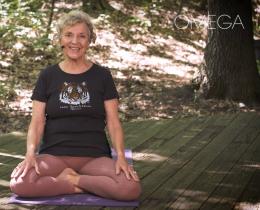Omega Institute and the Yoga Service Council have worked together since 2014 to produce a series of Yoga Service Best Practices Guides, including Best Practices for Yoga in Schools (2015) and Yoga With Veterans (2016), and most recently Best Practices for Yoga in the Criminal Justice System (2017).
These books are created not by one or two writers, but by a whole group of experts. In fact, each book begins with a symposium held at Omega’s Rhinebeck campus. Starting in 2014, each of these weeklong Yoga Service Best Practices Symposiums has brought together about 25 experts, who share yoga with specific populations.
For the Yoga in the Criminal Justice System book, symposium participants included Susanna Barkataki, who runs a pay-it-forward online meditation program called OM in 2 Bliss; Leslie Booker, a Yoga Service Council cofounder and current advisor; Denise Davidson, who has served as the warden of a women’s prison since 2013; Marshawn Feltus, a Chicago west-side native and founder of ACT yoga, the first yoga studio in Chicago’s Austin community; James Fox, the founder/director of Prison Yoga Project; Hala Khouri, cofounder of Off the Mat, Into the World; and many more.
“The Best Practices series is an invaluable resource for building the field of yoga service,” said Dr. Carol Horton, Yoga Service Council vice president and editor of Best Practices for Yoga in the Criminal Justice System. “Thanks to the relationships developed and knowledge shared during each symposium at Omega, we are able to share the hard-won knowledge and insights of many of the most experienced experts, sharing yoga in ways that promise to uplift not only particular populations, but society as a whole.”
At the Symposium
During their time together, the experts discuss best practices, laying the foundation for the next guide in the series. Participants engage in multiple rounds of intensive small group discussion, helping generate the raw material for the subsequent Best Practices book. Each group tackles a subtopic, such as "culture and communications issues," with discussion led by a facilitator and recorded by a contributing editor.
Preliminary sets of best practices get discussed and reviewed by the full group. After that, each contributing editor refines their notes and circulates them to their small group for review.
Finalizing the Book
This material is then sent to the editor, who integrates it into one manuscript. Once a full book draft is completed, it gets circulated back to each symposium participant for review.
Their final comments get incorporated into the manuscript and that draft goes to a panel of five external peer reviewers for further vetting and commentary. After their feedback has been integrated, the book goes to print.
Each book represents the integrated knowledge and experience of approximately 30 experts in the field, making it a one-of-a-kind resource for those interested in the topic.
The goal is to provide information that both yoga service organizations, individual yoga teachers, and interested professionals and staff that work with each population, can use to develop and sustain high-quality yoga programs crafted to serve the specific needs of that group.
The fourth title in the series, Best Practices for Yoga with Sexual Trauma Survivors, is in process and will be published in Fall 2018.



